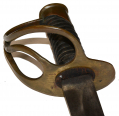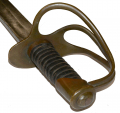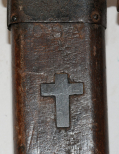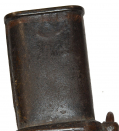site search
online catalog
CS ENLISTED CAVALRY SABER AND SCABBARD BY MARSHALL OR KRAFT, GOLDSCHMIDT AND KRAFT, WITH INLAID WESTERN THEATRE ROMAN CROSS

$8,500.00 SOLD
Quantity Available: None
Item Code: 870-682
Some collectors refer to this pattern as by Hammond Marshall and Company of Atlanta, who had an 1862 CS contract for 3,000 cavalry sabers, but attribution has largely come back to Kraft, Goldschmidt and Kraft of Columbia, S.C., first put forward by Albaugh in 1963, on the basis of the untwisted grip wire, use of brass ferrule at the bottom of the grip, and the long, nearly straight blade (somewhat in the British 1853 pattern cavalry sword,) all of which this sword exhibits, most especially in an impressive blade, about 36-inches long.
This sword also bears a soldier’s individual touch in the form of a pewter Roman Cross inlaid in the wood scabbard on the obverse side just below the upper mount. This could be a soldier’s individual expression of piety, but it may also indicate the sword saw service in the western theatre where the symbol, with all its religious associations and connotations of virtue intended, got its start as a replacement for the Saint Andrew’s Cross on Confederate flags with some Missouri regiments in Price’s Army of the West, and was then adopted by other regiments in the Confederate Department of Mississippi and East Louisiana.
Swords of this pattern may be seen in several collections, in including the Wray Collection in the Atlanta History Center. The brass hilt is a simplified copy of the US light cavalry saber, with rudimentary “Phrygian cap” pommel with dome and brim, and knucklebow with two side branches leading forward to the oval guard, which is finished, but flat and lacking contour. The side branches are rounded in the mid-section but become flat as they join the guard. The grip fairly straight, has a brass ferrule at the guard, is wrapped with black leather and bound with a simple single strand of iron wire. The leather is very good and wire is complete and tight. The pommel cap shows some dings on the side of the dome, but not on the top, perhaps to tighten it at some point, but the peening of the tang does not look disturbed and we do not think the sword has ever been apart. The brass has a nice, undisturbed, aged patina. Some spots on the counterguard and branches show original file marks from the workman finishing off the casting, but not going to a full polish. The middle branch also shows a small casting flaw that shows as a short crack near the base on the reverse side. The thin, brown leather blade pad is still in place on the underside of the guard, showing some crackling but only a little flaking. The blade is very good, with no nicks and good point, with an unstopped, single broad fuller and flat back. The metal is smooth, with no pitting, and shows as muted steel gray with thin, darker gray spots.
The wood scabbard is typical one for this saber. The same pattern also shows up on sabers made by B. Douglas of Columbia, so Douglas or K.G.&K. may have made them and wholesaled them to the other. They may also have come from another maker entirely, local or farther afield. One strong candidate is the firm of Lewis L. and T.R. Moore (possibly in Atlanta,) who supplied 556 wooden saber scabbards to the CS Arsenal at Charleston, S.C., in 1863. The construction is a tribute to Confederate material shortages and ingenuity. Two wood slats were mortised to receive a blade, joined together by pins, and painted with red varnish. They were bound with three tinned sheet iron mounts painted black and fitted with a brass throat, ring bands, and drag. The scabbards have naturally loose tolerances for the blades, making them perfect for use on swords by different makers.
The scabbard is complete and shows wear, but is in very good condition and matches the sword. The throat, ringbands, rings, and drag are all present and mounts show just about all of their original black paint. The wood scabbard body shows show dings and scratches, but is solid and has most of its reddish-brown color with just some lighter spots from abrasion. Just below the inlaid cross the there is a vertical line of marks that looks at first like some lettering had been crossed out, but seems rather to be some light chattering or dings to the wood. Above the cross is very clearly a CSA carved just below the edge of the upper mount. Although tempting to believe it is a soldier’s patriotic addition to the cross, it is most likely a later addition by a collector, dealer, or perhaps even family member, to make clear the Confederate association of the sword.
This is not only a great example of a southern cavalry saber, it is one of the few we have seen with a genuine personal touch added by a Confederate soldier. [sr] [ph:L]
~~~~~~~~~~~~~~~~~~~~~~~~~~~~~~~~~~~
THIS ITEM, AS WITH ALL OTHER ITEMS AVAILABLE ON OUR WEB SITE,
MAY BE PURCHASED THROUGH OUR LAYAWAY PROGRAM.
CLICK HERE FOR OUR POLICIES AND TERMS.
THANK YOU!
Inquire About CS ENLISTED CAVALRY SABER AND SCABBARD BY MARSHALL OR KRAFT, GOLDSCHMIDT AND KRAFT, WITH INLAID WESTERN THEATRE ROMAN CROSS
For inquiries, please email us at [email protected]
Most Popular
Historical Firearms Stolen From The National Civil War Museum In Harrisburg, Pa »
Theft From Gravesite Of Gen. John Reynolds »
Cavalry Carbine Sling Swivel »
Fine Condition Brass Infantry Bugle Insignia »
featured item
FANTASTIC UNIFORM GROUPING OF G.E. ANDREWS: OFFICER’S FROCK COAT, OFFICER’S SHORT JACKET, OFFICER’S TROUSERS, AND HIS TAILOR-MADE FIRST SERGEANT FROCK COAT WITH VETERAN SERVICE STRIPES!
We don’t often use exclamation points in a description, but this identified uniform grouping, formerly in the collections of the Texas Civil War Museum, has not just historical interest, but outstanding eye-appeal. The First Sergeant’s frock coat… (1179-147). Learn More »



















